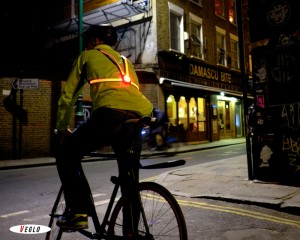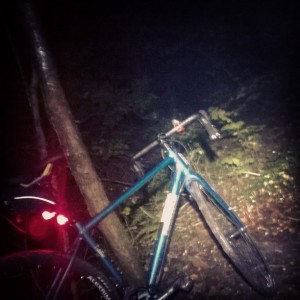
Riding in the dark isn’t everyone’s idea of fun. A lamp lit spin around lanes you know, or off-road – known as night riding – can actually be both liberating and very relaxing, but when the ride is simply about getting home, it can sometimes feel like a race for survival. Here are some tips to keep you safe…
1) Have good lights, that work
A good set of lights is your number one requirement for bike safety and safe cycling. If your route is unlit, you’ll be looking at an 800 lumen+ front beam that lights up the road and shows you your path.
Very often, those kind of lights will work on full power for an hour or so, and on half power for a few hours, and if you’ve got a flashing mode, much longer.
It’s crucial you know how long your light lasts for, ideally it will have an indication to show you when the battery is half full and a quarter full. Learn the battery life, and make sure you have a charging cable at home, and at work – so you can never forget.
If you use a bright light, do be responsible – direct it away from oncoming traffic if you’re on country lanes and using full power, and only use half power when in lit areas.
If you’re shopping around for bike lights, our best selling bike lights guide will help. A good set of lights is vital to bike safety and safe cycling.
2) Have back up lights
It shouldn’t happen with a good quality light, but it does – so make sure you have a set of back up lights in case your main light dies.
Do check the batteries are still fresh and that the light functions every couple of weeks, if it’s usually buried in the bottom of a backpack for some time.
It is a good idea to have two rear lights on at all times, in case one fails and you don’t realise.
This €3 set of bike lights will do the trick perfectly to get you home.

3) The ‘high viz’ question
High Vis Jackets, vital to bike safety and safe cycling!! Other visibility aids are contentious issues for some who claim lights are enough to ensure they are seen
I can vouch for the fact I’ve come across riders, without lights, in pitch black, and picked them out only for the reflector on their pedals. Obviously, start with lights – but if you can wear clothing with high viz elements (silver, yellow is debatable in fading light) and stay away from wearing all black.
4) Know your route
Proper lights should mean you can see your way, but it’s always reassuring if you know where the next bend is, where that crater of a pot hole is and where the road narrows.
Of course, you still need to be aware that changes may take place, but if you can stick to a route where you know the roads well it is a good idea.
However well you know your route, however, be respectful of the winter darkness – and slow down. It is ‘ok’ to ride slower in the dark, and it is much better to have a slower average speed, and get home safely, than to keep riding at full throttle and find yourself with a bent rim and bruised pride when you meet a pothole.
5) Modify your route if need be
My commute home finishes with a 20% hill, that’s completely unlit and currently covered in wet leaves – and thus I have a ‘summer route’ and a ‘winter route’. Admittedly, the ‘winter route’ is not as pleasant, its more traffic infested – but it’s also better lit, and the roads are smoother.
If your commute uses country lanes, that can become flooded, or strewn with debris, look for more urban routes. Failing that, do make sure you invest in some very reliable and heavy duty tyres (I have considered riding my ‘summer’ route aboard a cyclocross bike recently… then I discovered point 6)
6) Take it off road
If you’ve got a mountain bike, hybrid or cyclocross bike, it’s not a bad idea to include some off road portions in your route – this takes you away from the cars, and actually it’s a pretty fun way to inject some variety into what can sometimes feel like a hell of a slog.
Of course, riding off road takes away the traffic – but it does introduce you to wet roots, rocks and mud – only opt for this option if you have experience night riding off road (or with a friend you trust, assuming you’re prepared to fall in some mud some time).
7) Take a mate
This isn’t an option available for everyone, but if you work with or near a friend who also happens to live along your way home, arrange to ride together.
There is safety in numbers – two riders are more visible than one, and you’ll always have someone to stand beside the road with you whilst you fix a puncture (handy as an extra set of hands to hold a torch can make a big difference).
8) Stay in touch
If you don’t have the buddy option, try to make sure someone knows where you are, and make sure you’ve got battery on your phone.
Should you find yourself plunged into darkness, or struggling with two punctured tubes and no patches five miles from home, you will thank yourself- a long walk in the light is one thing, in the dark it’s a bit of an ordeal.



